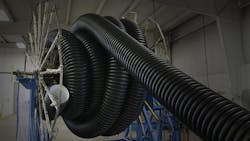Fratco
undefinedThe advent of modern plastic drainage pipe changed the landscape of both agricultural and commercial drainage, lowering costs, simplifying installation and creating a more durable product. But although the blend and efficiency of those plastic pipes have improved, not much progress has been made in the past few decades—until now.
For decades in the drainage industry, when professionals wanted the strength and smooth flow of a dual-wall pipe, they have been held hostage to laborious and inefficient installation techniques. That was the problem facing Zimpleman Excavating Inc. When installing an agricultural pattern-tile drainage system, owner Greg Zimpleman had two completely differently experiences. He would zip through single-wall, flexible laterals (the pipes that feed a bigger main line that terminates in a ditch) and submains. He then would have to install the inflexible dual-wall mains that would take hundreds of additional man-hours and slow his project to a snail’s pace. Everyone was up against the same problem.
The flexible, single-wall pipes arrive in “maxi-coils,” which—like a spool of thread by a sewing machine—are plowed directly into the earth at the precise depth and pattern required for the given project. The single-wall corrugated pipes have a slower flow rate and are not as strong as their smooth-core, dual-wall cousins.
Meanwhile, the rigid sticks of dual-wall pipe are installed by hand. A backhoe pulls away the earth, short sections of sticks are lowered into the ground, and they are pieced together, 10 ft at a time. Workers connect the pipes by hand and often drill sections together in a painstaking process. Zimpleman’s crews often are spending hours in the ditch, adjusting fittings, connecting sections, and trying to ensure that patterns and depths are consistent despite working by hand. Where other companies could cut corners, Zimpleman is insistent that his crews strive for the same level of precision when working by hand as they do when installing by machine.
All that work done with the precision required for optimal drainage performance means that installing dual-wall pipe is a source of frustration in the drainage business.
Engineers at Fratco have been researching this known pain point in the installation process. Led by fourth-generation owner and head engineer Chris Overmyer, the company began to toy with the creation of a flexible interior wall for dual-wall pipes. Trying a variety of different materials and techniques, Overmyer landed on a proprietary blend of polyethylene that could be flexed to coil without any loss to structural integrity. The result was something that has already changed the shape of Zimpleman’s business.
Zimpleman was an early adopter of Fratco’s new offering, FlexCorr. The product combines the flexibility of a single-wall pipe and the strength and high flow rate of dual-wall pipes. It has both an HDPE corrugated exterior and a smooth, flexible inner wall. The coiled dual-wall product often can be installed with the same machinery that Zimpleman has been using to efficiently install single-wall products, and it is always installed in longer pieces that are easier to handle.
Zimpleman believes that in just a few months, the new product has helped keep his company moving quickly through projects, getting more installations done this year than ever before. He has installed more than 20,000 ft of the pipe, in both 8- and 12-in. sizes. Zimpleman also has replaced a good amount of the single-wall submains with the product to improve flow rate. His new systems shave days off of his typical install time and an estimated 33% off man-hours.
Fratco assures users that the new product meets or exceeds standards that are applied to its strongest commercial-grade dual-wall offerings. And while AASHTO has not yet produced a standard for this pipe, it is likely to meet the demands of projects for decades to come.






